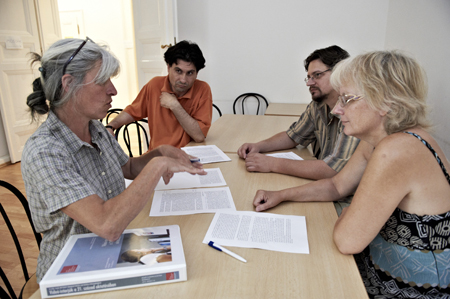Spotlight on Hungary

 Teaching with Testimony in the 21st Century, Hungary 2012
Teaching with Testimony in the 21st Century, Hungary 2012The Visual History Archive contains 786 testimonies recorded in Hungary and 1,338 Interviews in the Hungarian language. Central European University and Eötvos Loránd University (ELTE) have full access to the Visual History Archive, and four other sites have partial access. Szőnyi Benjámin Elementary and Middle School of the Reformed Church, Berzsenyi Daniel High School and István Bocskai High School are partner schools, working to incorporate testimony into their curriculum.
This month, Hungary became the first country to offer USC Shoah Foundation’s new ITeach professional development seminar. The seminar was organized in cooperation with local educational NGO Zachor Foundation and the Research Institute for Education Development.
ITeach is a one-day seminar, and it is led completely by presenters who are or were practicing classroom teachers. The seminar includes an introduction to USC Shoah Foundation’s educational programs, the Visual History Archive, methodology, social psychology and pedagogical theory and the introduction of a testimony-based lesson a teacher has already developed.
In addition, ITeach is intended for smaller or more remote communities so that teachers outside large cities – where Teaching with Testimony and other professional development programs are usually held – can attend. ITeach seminars are currently planned for 11 locations throughout Hungary and even across the border in Subotica, Serbia.
IWalks also got their start in Hungary. USC Shoah Foundation first launched IWalks in Budapest in 2013 in cooperation with the Zachor Foundation. The program includes peer-to-peer guided walks led by volunteers through the Jewish quarter of Pest – what used to be the Budapest ghetto area – and along the killing sites by the Danube. Film segments, which participants view on tablet devices during the walk, contain clips of testimony from the Visual History Archive in which survivors discuss their experiences at these very locations.
Hungary has hosted Teaching with Testimony in the 21st Century – USC Shoah Foundation’s flagship professional development program – since 2012. It is a two-year program that incorporates workshops, mentoring, and community building to prepare educators to search for and utilize testimony in the Visual History Archive and digital learning tools such as the Institute’s online education website IWitness. Participants, who are selected from applicants nationwide, create lessons using testimony and then pilot them in their classrooms. Recently, the Israeli ambassador to Hungary, Ilan Mor, observed a Teaching with Testimony graduate’s lesson during his visit to Berzsenyi Daniel High School.
Hungarian-language educational resources produced by the USC Shoah Foundation include Sodródás és szembenállás – Sorsok a vészkorszakban (Drifting and Opposition: Fates during the Shoah), Túlélés, Megmenekülés, Segítségnyújtás (Survival, Escape, Providing Help), and Megközelítések (Approaches): A teacher’s guide for the film A Holocaust Szemei (Eyes of the Holocaust), which was part of the Broken Silence series of documentaries produced by the Shoah Foundation in 2002. The
Liaisons have given presentations about the Visual History Archive and teaching with testimony at dozens of education and Holocaust conferences, to students at the Hungarian VHA access sites, and scholars.
USC Shoah Foundation website also includes a Hungarian portal featuring news and resources.
Learn more about USC Shoah Foundation’s work in Czech Republic and Poland.